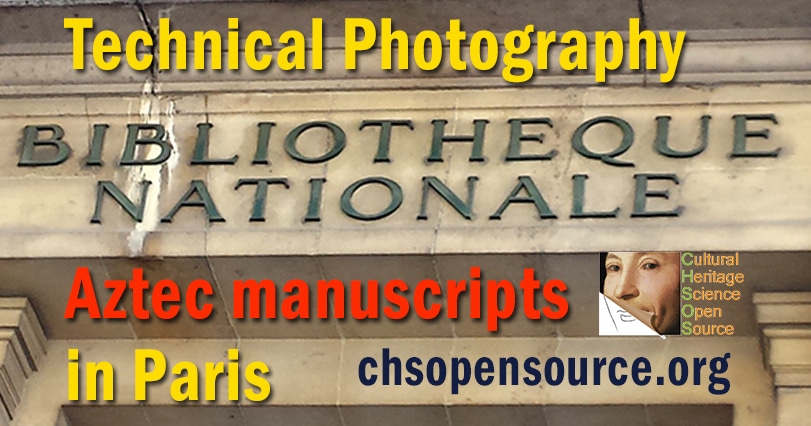
CHSOS was recently asked to perform Technical Photography documentation of the Codex Xolotl and Mapa Quinatzin at the Bibliothèque Nationale de France. Bothdocuments date to about 1540 AD. Both have European writing in the Aztec language, Nahuatl, on them that is no longer legible. They also have corrections to non-alphabetic indigenous writing with the potential to become legible through Technical Photography .
Dr Jerry Offner is Associate Curator of Northern Mesoamerica at the Houston Museum of Natural Science and he heads a volunteer group of scholars from France, Spain, Poland and Germany that has been studying the document and holding meetings on the document for nearly five years. Some members of the group having been studying the documents for more than four decades.
He got in contact with CHSOS to go to Paris and scan the document with Technical Photography.
The Codex Xolotl is the best example we have of Aztec historiography—their distinctive rules and methods for writing history. It portrays events from the 13th through the 15th century, ending nearly a century before Spanish contact. Its different pages or leaves were considered so important by the Aztecs that they were copied over and over across the contact boundary of 1519-1521 and assembled into what we call the Codex Xolotl by about 1540.


Dr Offner thought that Technical Photography on this codex would encourage an explosion of research and publication that would benefit the entire field of Mesoamerican studies—the indigenous cultures of Mexico, Guatemala, Honduras, etc.
On June 14th and 15th we documented the entire Codex Xolotl: eleven painted sides and three fragments. We also had time to examine the Mapa Quinatzin, generally regarded as the most important and beautiful of the documents from the Aztec “second city” of Tetzcoco (modern Texcoco, Mexico).
I would like to thank the Bibliothèque Nationale de France for allowing this examination and especially Laurent Héricher, Chef du service des manuscrits orientaux, Département des Manuscrits for facilitating this project. Many thanks also to John Hessler, the Library of Congress’s Curator of the Jay I. Kislak Collection of the Archaeology and History of the Early Americas and a “Specialist in Modern Cartography and Geographic Information Science” and Loïc Vauzelle, a graduate student at the Sorbonne who kindly assisted us during the examination.
The goal of this study was to produce a technical photography documentation of the manuscripts in the ultraviolet and infrared spectral range in order to:
- increase reading of faded inks and paints
- identify pigments and inks
- identify support paper
- differentiate inks
- evaluate and understand the transfer and non-transfer of images between the two larger fragments of the Codex Xolotl and the reverse of its first leaf.

This study aimed at evaluating how these technical photography methods could enhance reading of faded inks and paints on these very distinctive and indigenous kinds of manuscripts. They are indeed very different from European manuscripts whose supports and drawing and painting material are well known and studied. These Mesoamerican manuscripts were crafted using mostly supports and pigments available locally so it was not clear what information these imaging diagnostics techniques would be able to provide.
Examination Methods:
VIS. Standard visible light photography.
IR. Infrared photography (in raking light)
UVF. Ultraviolet photography
UVR. Reflected Ultraviolet.
A portable microscope 200-400 X was used to document features of the manuscripts.
VIS, IR, UVF, UVR.
These images were acquired using a modified full spectrum Nikon D800 camera and the Technical Photography Filters Set.


Technical Examination Services for Art and Archaeology
Manuscripts
Download Technical Examination for Paper Conservation (6224 downloads )









I am glad we could made it possible… Interesting! Please keep us updated…
The pleasure was mine! Very exciting and unique project. Now Dr. Offner has plenty of new data (images) to work with and pursue new research with his international team. Let me know if you have any question.
Working on mesoamerican artifacts is one on my personal aspirations!!! Come al solito complimenti!